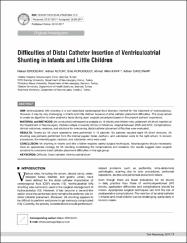Difficulties of Distal Catheter Insertion of Ventriculoatrial Shunting in Infants and Little Children
Özet
Aim:Ventriculoatrial (VA) shunting is a well-described cerebrospinal fluid diversion method for the treatment of hydrocephalus. However, it may be very challenging in infants and little children because of atrial catheter placement difficulties. This study aimed to create an algorithm to solve problems faced during open surgical procedures based on the present authors experience.Material and Methods:We conducted a retrospective analysis on 18 infants and children who underwent VA shunt insertion at the Department of Neurosurgery, Ondokuz Mayıs University School of Medicine Hospital between 2005 and 2012. Complications, clinical outcomes, revisions, and solutions for overcoming distal catheter placement difficulties were evaluated. Results:Twenty-six VA shunt operations were performed in 18 patients. Six patients required eight VA shunt revisions. VA shunting was primarily performed from the internal jugular, facial, cephalic, and subclavian veins to the right atrium. In revision procedures, the internal jugular, cephalic, and subclavian veins were used. Conclusion:VA shunting in infants and little children requires careful surgical techniques. Neurosurgeons should necessarily have an appropriate strategy for VA shunting considering the complications and revisions. Our results suggest open surgical solutions to overcome distal catheter placement difficulties in this age group.
Cilt
28Bağlantı
http://hdl.handle.net/11363/1050Koleksiyonlar
Aşağıdaki lisans dosyası bu öğe ile ilişkilidir:


















